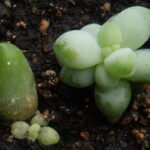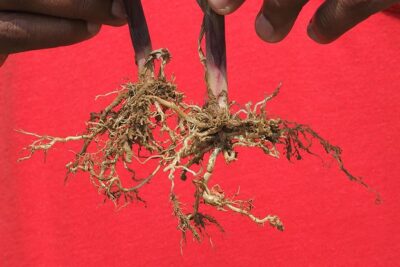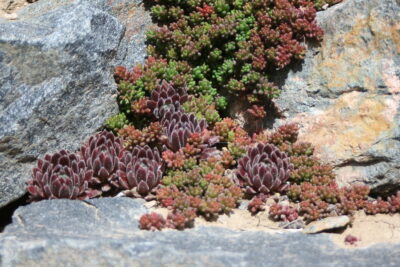
Step-by-Step Guide to Propagating Bear Paw Succulent from a Leaf

Bear Paw succulents, also known as Cotyledon tomentosus, are unique and fascinating plants that are beloved by succulent enthusiasts. Their distinctive paw-shaped leaves and fuzzy texture make them a popular choice for houseplant collectors. If you're looking to expand your succulent collection or simply want to try your hand at propagating these adorable plants, this step-by-step guide will walk you through the process of propagating Bear Paw succulents from a leaf.
We will explore the different methods you can use to propagate Bear Paw succulents from a leaf, including leaf cuttings and water propagation. We will provide detailed instructions on each step of the propagation process, from selecting a healthy leaf to caring for the new plantlet. Additionally, we will discuss common challenges and tips for success to help you achieve the best results. Whether you're a beginner or an experienced succulent gardener, this guide will give you the knowledge and confidence to propagate your own Bear Paw succulents and enjoy the satisfaction of watching them grow.
- Choose a healthy leaf from your bear paw succulent plant
- Gently remove the leaf from the stem using a clean, sharp knife or scissors
- Allow the leaf to callous over for a few days in a warm, dry location
- Prepare a well-draining potting mix for your new succulent
- Place the calloused leaf on top of the potting mix, with the stem side down
- Step 1: Prepare the Potting Mix
- Step 2: Select a Healthy Leaf
- Step 3: Allow the Leaf to Callous
- Step 4: Prepare a Small Pot
- Step 5: Plant the Leaf
- Step 6: Provide Adequate Light and Temperature
- Step 7: Water Sparingly
- Step 8: Patience is Key
- Step 9: Transplanting the New Plant
- Step 10: Care for Your New Bear Paw Succulent
- Mist the leaf occasionally to keep it hydrated during the propagation process
- Keep the potting mix lightly moist, but not overly wet
- Place the pot in a well-lit area, but avoid direct sunlight
- Over time, small roots and new leaves will begin to grow from the base of the leaf
- Once a sufficient root system has developed, you can transplant the new succulent into its own pot
- Continue to care for the new plant as you would with a mature bear paw succulent
- Frequently Asked Questions
Choose a healthy leaf from your bear paw succulent plant
To propagate a bear paw succulent from a leaf, you will first need to select a healthy leaf from your existing plant. Look for a leaf that is plump and fully grown, avoiding any leaves that are damaged or diseased.
Using a clean pair of scissors or pruning shears, carefully cut the leaf from the stem of the plant. Make sure to cut as close to the stem as possible, leaving a small portion of the stem attached to the leaf.
Note: It is important to use clean and sterilized tools to prevent the spread of diseases or pests to the plant.
Gently remove the leaf from the stem using a clean, sharp knife or scissors
 Propagating Succulent Leaves: A Guide to Growing New Plants
Propagating Succulent Leaves: A Guide to Growing New PlantsPropagating a Bear Paw Succulent from a leaf is an exciting and rewarding process that allows you to create new plants from an existing one. Whether you are a beginner or an experienced succulent enthusiast, this step-by-step guide will help you successfully propagate a Bear Paw Succulent from a leaf.
Step 1: Gather the necessary materials
- A healthy Bear Paw Succulent plant
- A clean, sharp knife or scissors
- A small container filled with well-draining soil
- A spray bottle filled with water
- Rooting hormone (optional)
Step 2: Prepare the leaf for propagation
Start by selecting a healthy leaf from your Bear Paw Succulent plant. It's crucial to choose a mature leaf that is plump and fully grown. Gently remove the leaf from the stem using a clean, sharp knife or scissors. Make sure to cut as close to the stem as possible to avoid damaging the leaf.
Step 3: Allow the leaf to callous
After removing the leaf, place it in a warm and dry location. Let it sit for a few days to allow the cut end to callous over. This callousing process is essential as it helps prevent rotting and promotes successful rooting.
Step 4: Prepare the soil
While the leaf is callousing, prepare the small container by filling it with well-draining soil. Bear Paw Succulents thrive in soil mixes that are specifically formulated for succulents and cacti. If desired, you can mix in some perlite or sand to improve drainage.
Step 5: Plant the leaf
Once the leaf has calloused, gently press the cut end into the soil, ensuring that the calloused portion is in contact with the soil. The leaf should be inserted deep enough to provide stability. If you are using rooting hormone, lightly dip the calloused end of the leaf into the hormone powder before planting.
Step 6: Provide proper care
Place the container in a bright location with indirect sunlight. Avoid exposing the leaf to direct sunlight as it can cause sunburn. Mist the soil with water using a spray bottle whenever it feels dry. Overwatering can lead to rotting, so make sure to allow the soil to dry out between waterings.
Step 7: Wait for new growth
Be patient and wait for new growth to emerge from the base of the leaf. It may take several weeks or even months for roots and new plantlets to develop. Once the new plantlets are well-established, you can transplant them into individual pots or leave them in the same container.
 Can You Propagate Donkey's Tail Succulent with Leaf Cuttings?
Can You Propagate Donkey's Tail Succulent with Leaf Cuttings?By following these steps, you can successfully propagate a Bear Paw Succulent from a leaf and enjoy the satisfaction of growing your succulent collection. Remember to be patient, as the propagation process takes time, but the end result is definitely worth it!
Allow the leaf to callous over for a few days in a warm, dry location
Before you begin propagating your Bear Paw Succulent, it’s important to allow the leaf to callous over. This step is crucial in preventing any potential rot or infections during the propagation process.
Find a warm and dry location, ideally with good air circulation, to place the leaf. This can be a sunny windowsill or a well-ventilated room. Avoid direct sunlight, as it may scorch the leaf.
Place the leaf on a clean surface and let it sit undisturbed for a few days. During this time, the exposed end of the leaf will dry out and form a callus, which is a protective layer that helps prevent moisture loss and infections.
It’s important to note that the length of time required for callusing may vary depending on environmental conditions. In general, a few days should suffice, but if the leaf feels dry and calloused to the touch, it’s ready for the next step.
Pro tip: If you're propagating multiple leaves, it’s a good idea to label them to keep track of their progress and ensure you don't mix them up.
 Succulent Propagation: Home Techniques for Thriving Varieties
Succulent Propagation: Home Techniques for Thriving VarietiesPrepare a well-draining potting mix for your new succulent
Before you start propagating your Bear Paw Succulent from a leaf, it's crucial to ensure that you have the right potting mix. Bear Paw Succulents thrive in well-draining soil that mimics their natural habitat.
To create the perfect potting mix, follow these steps:
- Gather the necessary materials: You will need a container for mixing, peat moss, perlite, and coarse sand. These components will help improve drainage and prevent waterlogged soil.
- Measure the ingredients: In your mixing container, combine equal parts peat moss and perlite. Add a smaller amount of coarse sand to the mix, ensuring a ratio of approximately 2:1:1.
- Mix thoroughly: Use your hands or a trowel to blend the ingredients together until they are evenly distributed. This will ensure a consistent texture and prevent any clumping.
- Test the moisture level: Take a handful of the potting mix and squeeze it tightly. If it holds its shape but breaks apart easily when touched, you have achieved the right moisture level.
Remember, the key is to create a well-draining potting mix that allows excess water to flow through, preventing the roots from sitting in damp conditions that can lead to root rot.
Now that you have prepared the perfect potting mix, you are ready to move on to the next step in propagating your Bear Paw Succulent from a leaf.
Place the calloused leaf on top of the potting mix, with the stem side down
Step 1: Prepare the Potting Mix
Before propagating your bear paw succulent, it's essential to have the right potting mix. Prepare a well-draining mixture by combining equal parts of cactus soil, perlite, and coarse sand. This blend ensures proper moisture retention without causing the roots to become waterlogged.
 Fast-Spreading and Prolific Succulents: A Guide to Rapid Propagation
Fast-Spreading and Prolific Succulents: A Guide to Rapid PropagationStep 2: Select a Healthy Leaf
Choose a mature and healthy leaf from your bear paw succulent plant. Look for a leaf that is firm, plump, and free from any signs of damage or disease. Gently twist the leaf from the stem, ensuring that you get a clean break.
Step 3: Allow the Leaf to Callous
Place the detached leaf in a warm and dry location, away from direct sunlight. Allow it to sit for a few days until a callus forms over the broken end. This callus acts as a protective layer and helps prevent rot when the leaf is planted.
Step 4: Prepare a Small Pot
Fill a small pot with the prepared potting mix, leaving some space at the top for the leaf and roots. Bear paw succulents have shallow roots, so a smaller pot will be sufficient for propagation. Make sure the pot has drainage holes to prevent waterlogging.
Step 5: Plant the Leaf
Place the calloused leaf on top of the potting mix, with the stem side down. Gently press it into the soil, ensuring good contact with the potting mix. The leaf should be partially buried, but the top portion should remain exposed above the soil surface.
Step 6: Provide Adequate Light and Temperature
Find a bright location for your newly planted leaf, but avoid direct sunlight as it can scorch the delicate leaf. Bear paw succulents thrive in temperatures between 65-85°F (18-29°C). Maintain a warm and well-lit environment to encourage successful propagation.
Step 7: Water Sparingly
Water the planted leaf sparingly, allowing the soil to dry out between waterings. Overwatering can lead to root rot and hinder the propagation process. Aim to keep the potting mix slightly moist but not soggy.
Step 8: Patience is Key
Propagation can take several weeks or even months, so be patient and resist the urge to disturb or check on the leaf too frequently. Keep a watchful eye for any signs of new growth, such as tiny roots or small plantlets emerging from the base of the leaf.
 Can Succulent Leaves Regrow Once They Drop?
Can Succulent Leaves Regrow Once They Drop?Step 9: Transplanting the New Plant
Once the leaf has successfully propagated and developed a sufficient root system, you can consider transplanting it into a larger pot. Use a well-draining potting mix similar to the one used for propagation and ensure the new pot has adequate drainage holes.
Step 10: Care for Your New Bear Paw Succulent
Continue providing your newly propagated bear paw succulent with the care it needs. Place it in a location with bright, indirect sunlight and water it sparingly, allowing the soil to dry out between waterings. With time and proper care, your new succulent will grow into a beautiful, mature plant.
Mist the leaf occasionally to keep it hydrated during the propagation process
Proper hydration is essential for the successful propagation of a bear paw succulent leaf. To ensure that the leaf remains hydrated throughout the process, it is recommended to mist it occasionally. This helps to maintain the moisture levels necessary for root development.
When misting the leaf, make sure to use clean water at room temperature. Avoid using water that is too cold or hot, as extreme temperatures can shock or damage the leaf. Additionally, it is important to avoid spraying water directly onto the leaf's surface, as this can cause rot or fungal issues.
Instead, aim to mist the surrounding area of the leaf, allowing the water droplets to settle on the nearby soil. This will create a humid environment around the leaf, promoting healthy growth. It is important not to over-mist the leaf, as excessive moisture can lead to rotting. A light misting every 2-3 days should be sufficient to keep the leaf hydrated.
Tip: If you notice that the leaf is starting to shrivel or dry out, increase the frequency of misting. However, always ensure that the leaf is not sitting in standing water, as this can also lead to rot.
 Can Succulent Leaves Grow Roots When Planted in Soil?
Can Succulent Leaves Grow Roots When Planted in Soil?Keep the potting mix lightly moist, but not overly wet
When propagating a Bear Paw Succulent from a leaf, it is important to keep the potting mix lightly moist, but not overly wet. Overwatering can lead to rotting of the leaf and hinder the propagation process. It is crucial to strike the right balance to provide the necessary moisture for root development.
Place the pot in a well-lit area, but avoid direct sunlight
When propagating a Bear Paw Succulent from a leaf, it is important to provide the right amount of light for optimal growth. Place the pot in a well-lit area, but take care to avoid direct sunlight. Direct sunlight can cause the leaves to burn and may hinder the propagation process. It is best to choose a spot near a bright window or under a grow light to provide the necessary light for the succulent.
Over time, small roots and new leaves will begin to grow from the base of the leaf
Propagating bear paw succulent from a leaf is a rewarding and fascinating process. By following a few simple steps, you can create new plants from a single leaf, allowing you to expand your succulent collection or share them with friends.
Step 1: Choose a Healthy Leaf
Start by selecting a healthy leaf from your bear paw succulent. Look for a plump, mature leaf that is free from any signs of damage or disease. Gently twist the leaf from the stem, ensuring that a clean break is made.
Step 2: Allow the Leaf to Callus
 Can Succulent Leaves Regrow Once they Fall Off?
Can Succulent Leaves Regrow Once they Fall Off?Place the detached leaf in a warm, dry location and allow it to callus for a few days. This step is crucial as it helps to prevent rotting once the leaf is planted. Ensure that the cut end is facing up to promote proper growth.
Step 3: Prepare a Well-Draining Soil Mix
In the meantime, prepare a well-draining soil mix for your bear paw succulent leaf. A combination of cactus soil and perlite or pumice works well to create the ideal growing conditions. Fill a small pot with the soil mixture, leaving about an inch of space at the top.
Step 4: Plant the Leaf
Gently press the callused end of the leaf into the soil, ensuring that it is firmly in place. Avoid burying the leaf too deep; it should be partially above the soil surface. This allows the leaf to receive sufficient light and encourages the growth of new roots.
Step 5: Provide Adequate Light and Water
Place the potted leaf in a bright location that receives indirect sunlight. Bear paw succulents thrive in bright but filtered light conditions. Water the leaf sparingly, allowing the soil to dry out completely between waterings. Overwatering can lead to root rot and hinder the propagation process.
 Succulent Pruning: Master the Art of Stem Cutting with Expert Tips
Succulent Pruning: Master the Art of Stem Cutting with Expert TipsStep 6: Be Patient and Watch for New Growth
Now, it's time to be patient and wait for nature to work its magic. Over time, small roots and new leaves will begin to grow from the base of the leaf. This is a sign that your propagation efforts have been successful. Be sure to continue providing the right conditions of light and watering to promote healthy growth.
Step 7: Transplanting the New Plant
Once the new plant has established a strong root system and multiple leaves, it is ready to be transplanted into its permanent container. Gently remove the new plant from the pot, taking care not to damage the delicate roots. Plant it in a well-draining succulent potting mix, and continue to care for it as you would any mature bear paw succulent.
By following these step-by-step instructions, you can successfully propagate your bear paw succulent from a leaf and enjoy the satisfaction of growing new plants. Remember to have patience and provide the right conditions for optimal growth. Happy propagating!
Once a sufficient root system has developed, you can transplant the new succulent into its own pot
Transplanting your propagated bear paw succulent into its own pot is an exciting milestone in the propagation process. It's crucial to ensure that the new plant has a suitable environment to continue growing and thriving. Follow these step-by-step instructions to transplant your propagated bear paw succulent successfully:
 Succulent Resilience: Regrowth After Cutting or Damage
Succulent Resilience: Regrowth After Cutting or Damage- Choose the right pot: Select a pot that is slightly larger than the current container or the size appropriate for the root system. Make sure the pot has drainage holes to prevent waterlogging.
- Prepare the potting mix: Use a well-draining succulent or cactus potting mix. You can also create your own mix by combining regular potting soil with perlite or pumice to enhance drainage.
- Remove the succulent from the propagation container: Gently loosen the soil around the roots of the new succulent, making sure not to damage them. Carefully lift the plant out of the container.
- Inspect the roots: Take a moment to examine the root system. Trim any damaged or rotten roots using clean and sterilized pruning shears. This will encourage new healthy root growth.
- Place the succulent in the new pot: Position the bear paw succulent in the center of the new pot, ensuring that it sits at the same level it was in the propagation container. Fill the pot with the prepared potting mix, gently pressing it down around the roots to secure the plant.
- Water and settle the soil: Give the newly transplanted succulent a thorough watering, allowing the water to soak through the soil and drain out of the pot's bottom. This will help settle the soil around the roots.
- Find the right spot: Place the potted bear paw succulent in a location that receives bright, indirect sunlight. Avoid placing it in direct sunlight, as this can cause sunburn on the leaves.
- Care for the newly transplanted succulent: Keep an eye on the moisture level of the soil and water only when the top inch of the soil feels dry. Avoid overwatering, as succulents are prone to root rot. Provide occasional misting to maintain humidity.
- Monitor and enjoy: Over time, the transplanted bear paw succulent will continue to grow and thrive in its new pot. Monitor its progress, adjust care as needed, and enjoy the beauty of your successfully propagated succulent!
Transplanting your bear paw succulent from leaf propagation is a rewarding experience. By providing it with the right pot, soil, and care, you're giving your new succulent the best chance to flourish and become a stunning addition to your plant collection.
Continue to care for the new plant as you would with a mature bear paw succulent
Once you have successfully propagated a bear paw succulent from a leaf, it is important to continue caring for the new plant to ensure its healthy growth. Although it may be small in size initially, with proper care and attention, it will eventually grow into a mature and beautiful succulent.
Watering
Watering is a crucial aspect of succulent care, and the same applies to the newly propagated bear paw succulent. It is important to water the plant sparingly, allowing the soil to dry out between waterings. Overwatering can lead to root rot and other issues, so it is better to underwater than overwater. Make sure to water the plant at the base, avoiding direct contact with the leaves to prevent rotting.
Lighting
Bear paw succulents thrive in bright, indirect light. After propagating a new plant, place it in a location where it can receive ample sunlight. However, be cautious of exposing it to direct sunlight, especially during the hottest parts of the day, as this can cause sunburn and damage the leaves. A window sill or a spot near a well-lit area indoors can be ideal for providing the right amount of light.
Temperature
Bear paw succulents prefer warm temperatures, ideally between 65°F to 80°F (18°C to 26°C). They don't tolerate extreme cold or frost well, so it is important to protect them from freezing temperatures. If your climate experiences cold winters, it is best to bring your bear paw succulent indoors or provide it with proper insulation.
Soil and Fertilizer
When it comes to soil, bear paw succulents prefer a well-draining mix that allows excess water to flow out easily. You can use a commercial cactus or succulent soil mix or create your own by combining regular potting soil with perlite or sand to improve drainage. Fertilize the plant sparingly, using a balanced succulent fertilizer during the growing season (spring and summer) to provide essential nutrients.
 Can You Propagate Succulents by Growing New Plants from Leaves?
Can You Propagate Succulents by Growing New Plants from Leaves?Pests and Diseases
Like any other succulent, bear paw succulents can be susceptible to common pests such as mealybugs and spider mites. Regularly inspect your plant for any signs of pests and take appropriate measures to eliminate them. Additionally, be mindful of overwatering and ensure proper air circulation to prevent fungal diseases.
By following these care guidelines, your newly propagated bear paw succulent will thrive and grow into a stunning plant. With patience and attention, you can enjoy the beauty of this unique succulent for years to come.
Frequently Asked Questions
1. How long does it take for a bear paw succulent leaf to root?
It typically takes around 2-4 weeks for a bear paw succulent leaf to develop roots and start growing a new plant.
2. Can I propagate a bear paw succulent leaf in water?
Yes, you can propagate a bear paw succulent leaf in water. Simply place the leaf in a container with water, making sure only the base is submerged, and wait for roots to form.
3. How often should I water the propagated bear paw succulent leaf?
Water the propagated bear paw succulent leaf sparingly, only when the soil feels completely dry. Overwatering can lead to rotting of the leaf or root system.
4. When should I transplant the rooted bear paw succulent leaf into a pot?
Transplant the rooted bear paw succulent leaf into a pot once the roots are at least 1-2 inches long. This ensures that the new plant has a strong root system to support its growth.
If you want to read more articles similar to Step-by-Step Guide to Propagating Bear Paw Succulent from a Leaf, you can visit the Propagation category.






You Must Read